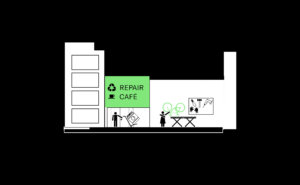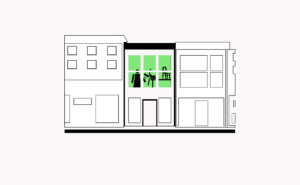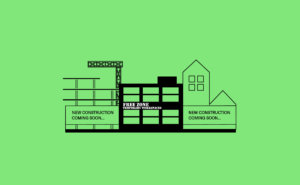
B.1 Making Around Courtyards
Organising manufacturing around courtyards inside blocks allows businesses to make noise, dust, move vehicles safely and provides additional space outside of the workshop area while allowing cohabitation with some forms of mixed use.
[Context] Historically internal yards in many urban blocks accommodated manufacturing, giving space for logistics and outdoor workspaces. The yard was treated as a flexible space that allowed businesses to grow and adapt. Courtyards also helped to divide staff from visitors and protect goods and equipment as gates could be easily closed and locked. This logic is being revived as it is seen as a feasible solution for mixed use activities where noise, dust and heavy vehicles can be comfortably contained within the courtyard area. The concentration of various businesses or manufacturing activities around a courtyard creates a semi-private community which can help build trust and exchange. Making around courtyards is a useful solution for sites located at the N.11 Back of the High Street where logistics, noise and dust could be problematic for the cleaner retail or commercial environments on the high street. Furthermore, courtyards do not need to be open and may be covered (by a roof or building) to allow these spaces to be useful in all weather conditions.
[Problem] In regeneration or redevelopment projects, many interior block spaces are being transformed into dwellings, gardens or to accommodate offices to increase land values. In many newly built blocks, courtyards are too small to accommodate services and logistics that manufacturing would benefit from (see B.2 Yard for Logistics). Furthermore, old and poorly insulated buildings located near residential units can be create conflict due to noise concerns.
[Forces] Making around courtyards will often occur in inner-city areas and sites located near residential areas as a solution for minimising impact on neighbours, for reducing exposure to theft and for safety. Sites located in gentrifying neighbourhoods may be under pressure from real estate development to develop all parts of the site into the highest value activity. Co-location projects can also heavily limit the kinds of manufacturing that could occur around courtyards with noise moving up building structures or dust blown to floors above the manufacturing spaces. Furthermore, developers of recently built co-location projects may be very tempted to lease out their manufacturing spaces as retail or office space to gain higher rental return with lower impact on the neighbours.
[Solutions] Build manufacturing around courtyards to encourage informal relationships between makers, to create a buffer space for occasional tasks demanding larger amounts of space and to reduce the impact of nuisances on neighbours. Making around courtyards should include a clear entry and exit for both security and safety. The courtyard can come in a range of sizes, which will depend on the kind of activities that will occur in the yard, the cost of land and requirement for logistics. If possible, allow space for vehicles to turn in the yard, or a thoroughfare to the back of the building allowing for a B.2 Yard for Logistics and B.6 Easy Loading & Unloading. A lane in between yards can be useful for logistics. Making around courtyards can be combined with multi-storey industrial intensification facilities so long as there is a suitable goods lift or ramp (B.5 Enabling Vertical Making). Suitable acoustic insulation and structurally detached units are key to avoid noise and vertical vibrations transmitted towards co-located dwellings. In high density areas the courtyards could be covered by roofs, minimising the exposure to noise and dust. In co-location projects, one or more units could be dedicated to the residents of the block, which would give an added value for the neighbourhood. Making around courtyards can be ideally combined with P.2 Shared Technology & Making Spaces to help share costs. To strengthen the position of manufacturing activities around courtyards, co-location projects could benefit from a R.3 Curator or being owned by a public actor, providing a C.3 Balance between Public & Private Land.
[Contribution] Add contributions here.







